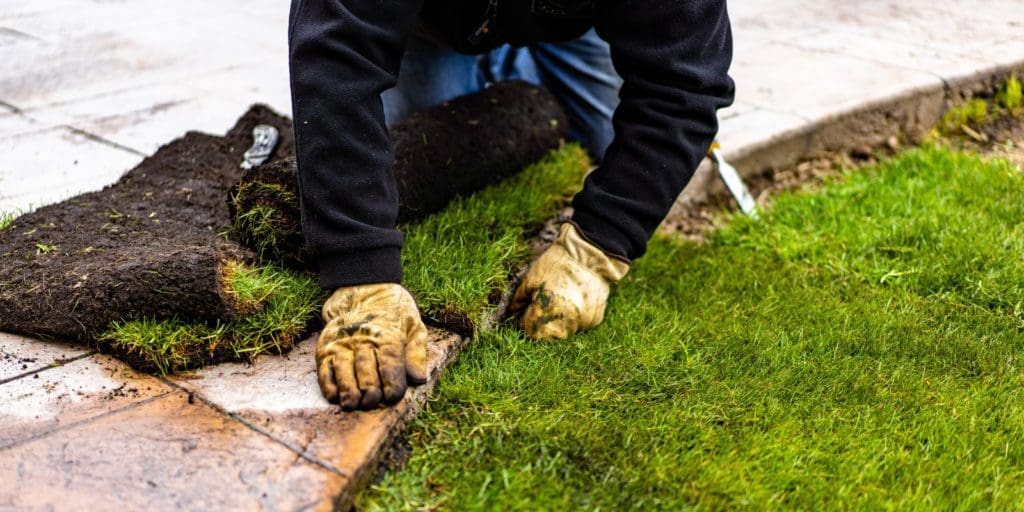It can be very frustrating if you have problems with your newly laid turf. You don’t want to dig up and replace it on a frequent basis. Thankfully, there are solutions to these problems. Checking, maintaining, and treating your turf before problems arise is the best way to keep it looking great all year round. In this article, we will show you the most common problems you might face and the reasons why you should carefully choose your turfing service provider in London.
1. The edges and the gaps
The edges and gaps of the turfing are a very common problem. It is caused by improper installation, inadequate soil preparation, poor quality turf, or incorrect cutting of the turf.
The edges and gaps can create a tripping hazard and allow weeds to grow in between the pieces of turf. To prevent this from happening, it’s important to make sure that the turf is installed correctly and with enough soil beneath it. You should always use high-quality turfgrass with good disease resistance to ensure that your lawn will stay healthy for years to come.
When cutting the turf, be sure to overlap each piece slightly when connecting them together so there are no gaps or edges that could lead to problems down the line. Taking these steps will help keep your lawn looking great and free from any potential hazards.
2. Weed Growth
Weed growth can get you very annoyed because it can be difficult to get rid of. Weeds can spread quickly and can become invasive if they’re not managed properly.
The best way to prevent weed growth is to keep your turf healthy and well-maintained with regular mowing, aeration, fertilizing and irrigation. Make sure to pull up any weeds you see either by hand or using an herbicide.
Lay down a weed barrier fabric or mulch to inhibit weed growth in the future. With these steps in place, you can help keep your lawn looking lush and healthy without the frustration of having to battle weeds all season long.
3. Moss Buildup
Moss buildup is a very serious problem that you should take actions against if you spot it early.
As a first step, you should rake the affected area to remove any dead moss and debris. Next, use a moss killer or fungicide specifically designed for this purpose. This will help prevent new moss from forming and can also break down existing material.
Promote healthy grass by mowing regularly and watering properly to ensure that the turf is receiving adequate nutrients. The aeration can help loosen compacted soil and improve air circulation which will create an environment inhospitable for moss growth.
4. Hard surfaces – such as concrete paths
The final turfing related problem that we would tackle is the hard surfaces in your garden such as concrete paths. They absorb and reflect heat which can dry out the soil beneath it, leading to an unhealthy lawn or garden. This is particularly problematic when you have large areas of concrete such as driveways and pathways that are exposed to direct sunlight.
The heat from the concrete causes the soil to become dry and cracked, making it difficult for grass and other plants to grow. To help prevent this issue, try adding mulch or other groundcover around hard surfaces to help reduce the amount of heat absorbed by the concrete and keep the soil moist.
Consider using a reflective paint on any exposed concrete surfaces in order to redirect some of that heat away from your turf. By doing these simple steps, you can help keep your turf healthy during hot summer days.
5. Over-watering your turf is wrong
Over-watering your turf is wrong and can have major implications on its health. Too much water can cause the soil to become saturated, reducing oxygen levels, which will make it difficult for grass roots to survive. Over-watering can also create a hospitable environment for fungus and disease, as well as an ideal habitat for pests.
This not only hurts the overall appearance of your lawn but can also kill off the grass entirely. To avoid over-watering, you should use a moisture meter to measure the soil’s moisture level before deciding how much water to apply. You should also ensure that you are using the correct amount of fertiliser, as this can affect how quickly water is absorbed by the soil.
It’s important to ensure that water is evenly distributed across your entire lawn; this will help keep all areas healthy and looking great!
Conclusion
Keeping your turf well maintained will help you to not face these turfing problems. It’s very important to act when you first see a sign of anything of the problems we talked about in this article. At the end of the day if the things get really serious and you can’t do anything to help your turf, you can rely on professional help.

